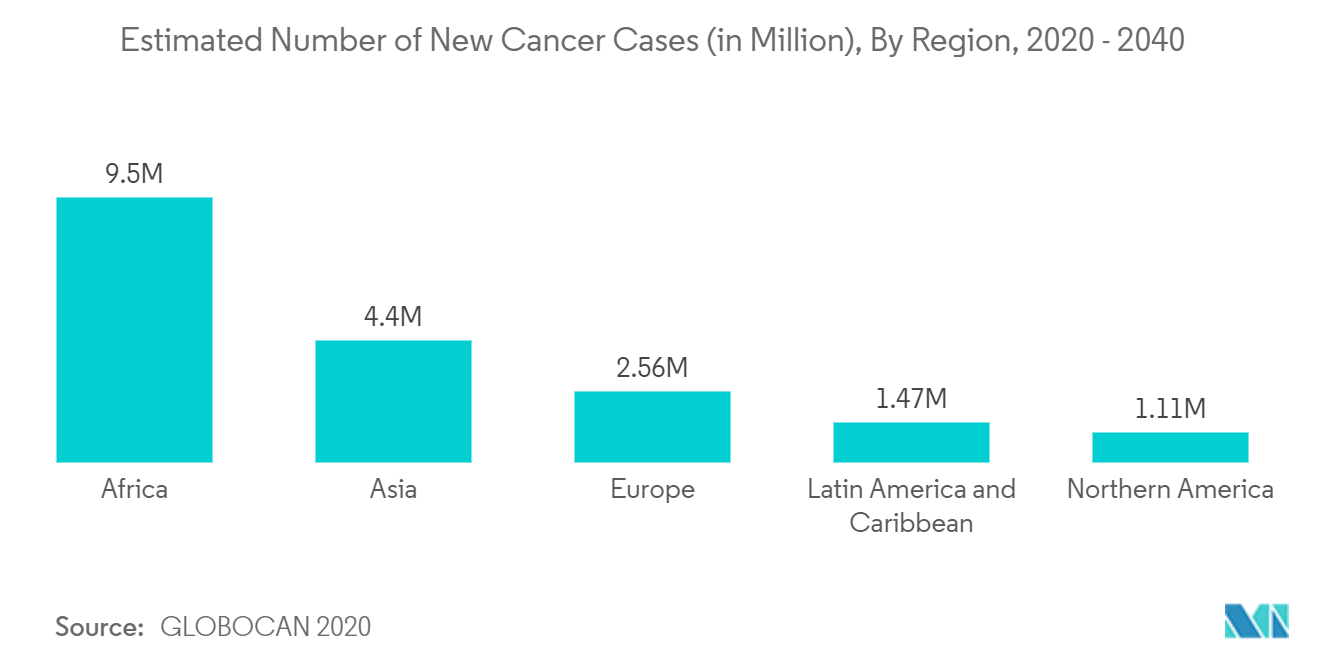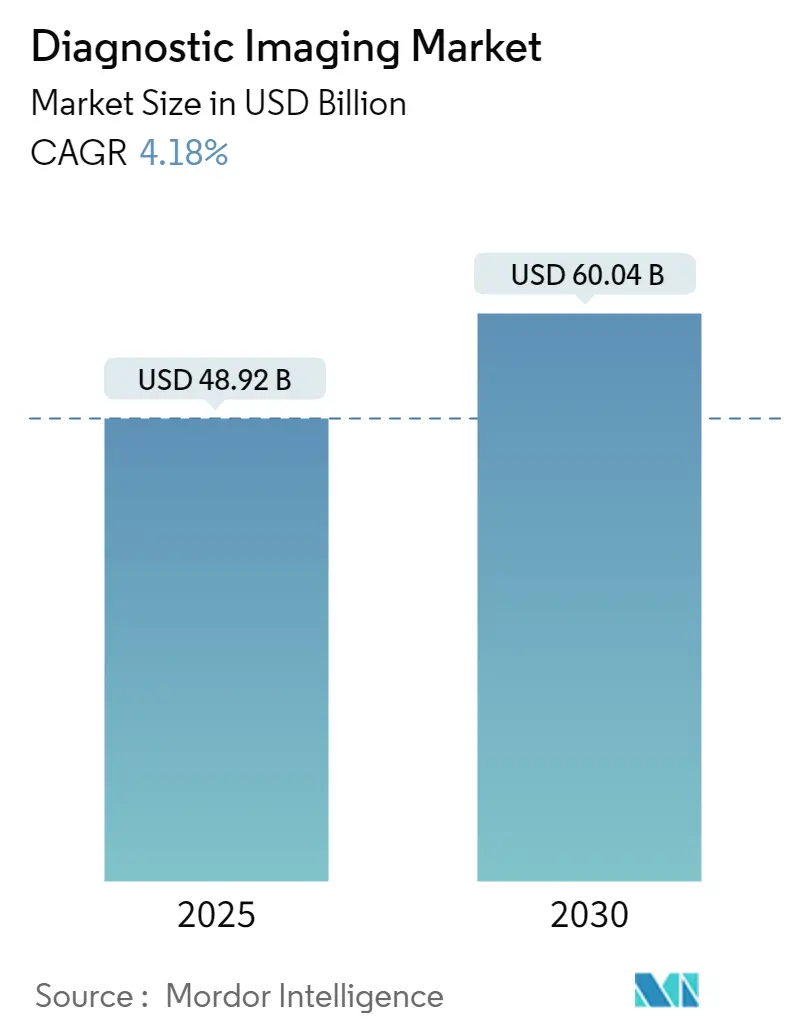
| Study Period | 2019 - 2030 |
| Market Size (2025) | USD 48.92 Billion |
| Market Size (2030) | USD 60.04 Billion |
| CAGR (2025 - 2030) | 4.18 % |
| Fastest Growing Market | Asia Pacific |
| Largest Market | North America |
| Market Concentration | Low |
Major Players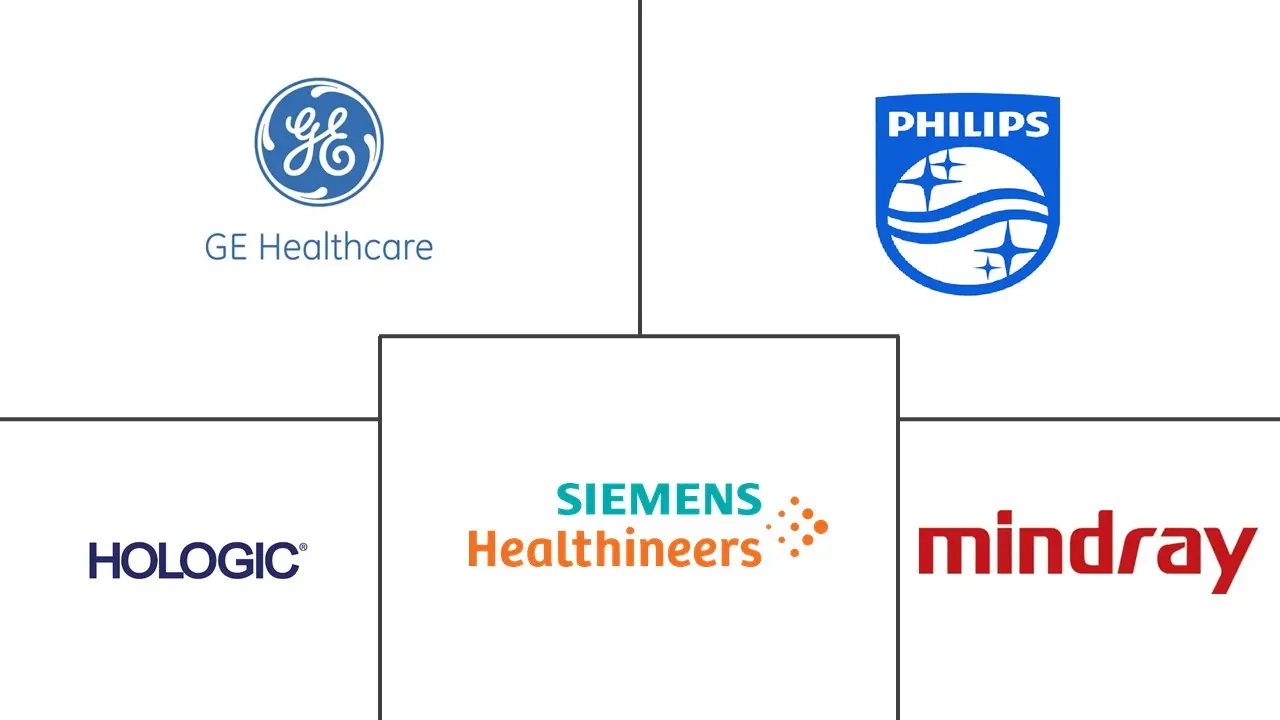
*Disclaimer: Major Players sorted in no particular order |
Diagnostic Imaging Market Analysis
The Diagnostic Imaging Market size is estimated at USD 48.92 billion in 2025, and is expected to reach USD 60.04 billion by 2030, at a CAGR of 4.18% during the forecast period (2025-2030).
The COVID-19 pandemic was expected to have a significant impact on the market. According to an article published in European Radiology in November 2020, chest radiography was useful in identifying COVID-19 patients who may rapidly deteriorate and helping inform clinical management and hospital bed and ventilation allocation. This increased the demand for chest radiography during the pandemic phase. Similarly, in April 2020, the National COVID-19 Chest Imaging Database (NCCID) was launched in the United Kingdom, which provides a more comprehensive understanding of COVID-19 by collating X-rays, CT, and MRI scan data from 20 NHS trusts across the country to detect disease patterns and markers of the virus using Artificial Intelligence (AI), which, in turn, enabled more accurate early diagnoses and prognoses. This is expected to boost the demand for such equipment and tests during the COVID-19 pandemic. In addition, the demand for diagnostic imaging is expected to remain constant due to the reopening of diagnostic clinics and hospitals with high patient inflow, thereby contributing to the growth of the market over the coming five years.
The main things that are driving the growth of the diagnostic imaging market are the increase in chronic diseases, the rise in the number of older people, and the use of more advanced imaging technologies.
The burden of chronic diseases is on the rise globally, and medical imaging procedures play a crucial role in the accurate diagnosis of chronic diseases, thereby contributing to the growth of the market. According to GLOBOCAN, in 2020, about 19.3 million new cases of cancer were reported worldwide, and this number is expected to increase to 30.2 million in 2040. Such an increase in cancer cases is expected to contribute to the growth of the market over the forecast period. Similarly, the British Heart Foundation data published in January 2022 reported that the most common heart conditions affected globally were coronary (ischemic) heart disease (global prevalence estimated at 200 million), peripheral arterial (vascular) disease (110 million), stroke (100 million), and atrial fibrillation (60 million). Such a large prevalence globally is fueling the growth of the market.
Additionally, the increasing number of product launches is expected to contribute to the growth of the market. For instance, in March 2021, Hitachi Medical Systems launched two permanent open MRI systems, APERTO Lucent Plus and AIRIS Vento Plus, at the start of the 2021 European Congress of Radiology. Both systems are equipped with SynergyDrive workflow solutions.
Thus, the above-mentioned factors are expected to contribute to the growth of the market over the forecast period.
Diagnostic Imaging Market Trends
Mid-range Scanners (~64-Slice) Segment under Computed Tomography expected to Account for Largest Market Share during the Forecast Period
Mild-range scanners are expected to hold a significant share in the growth of the market over the forecast period. Companies took several definite measures in order to keep up with the growing demand for scanners all over the world. Mid-range CT scanners are better for performing angiography in comparison with low-range CT scanners. Its characteristics, such as high speed and sensitivity, allow healthcare professionals to view the walls of arteries for plaque formation and to observe the tiniest of vessels and arterial branches, making it well suited for cardiac studies.
To grow their presence in the market, companies are continuously engaged in the development of new products, which in turn contributes to the growth of the segment. For instance, in January 2020, Allergen, in collaboration with Canon Medical Systems Corporation, introduced a new CT scanner in the market, the ACUTOM 32, which is a 32-slice CT scanner featuring a wide bore gantry of 32 cm, about a 2.0 MHU X-ray tube, and about 0.75 seconds of rotation time. Similarly, in January 2022, the Port Perry Hospital Foundation (PPHF) surpassed its goal of raising USD 4 million to bring a CT scanner and other essential equipment to the Scugog healthcare center. In February 2020, Samsung NeuroLogica made more of its 32-slice CT scanner, the mobile BodyTom, because COVID-19 cases were rising quickly.It allows scanning of COVID-19 patients at the point of care due to its internally shielded design and, at the same time, minimizes exposure to the virus. Because of this, the segment being studied is expected to grow over the next few years.
So, the growth of the market is likely to be fueled by the release of more CT scanners.
North America is Expected to Dominate the Market Over the Forecast Period
North America was found to hold a major share of the diagnostic imaging market and is expected to show a similar trend over the forecast period. This is mainly due to the rising prevalence of chronic diseases and the high demand for advanced diagnostic imaging.
The United States contributes the largest share of the diagnostic imaging market, which can be attributed to increasing technological advances, higher affordability rates among the population, and an increase in the number of diagnostic procedures each year.Furthermore, the market is expected to grow during the forecast period due to the presence of well-established healthcare facilities, rising demand for advanced healthcare systems among the aging population, and the rising prevalence of chronic diseases.For instance, the data published by the American Cancer Society in 2022 mentioned that a total of 1.9 million new cancer cases are expected to occur in the United States in 2022. Also, the growing number of neurological disorders such as brain tumors is expected to propel market growth. As per the American Cancer Society Journal article published in 2022, in 2021, an estimated 83,750 individuals were diagnosed with brain and other central nervous system tumors in the United States.
Also, the increasing number of product launches is expected to contribute to the growth of the market over the forecast period. For instance, in December 2021, Fujifilm Healthcare launched the Velocity MRI system, its advanced, high-field open MRI, during the 2021 Radiological Society of North America conference in Chicago.
Because of all of these things, the market is expected to grow in this region over the next few years.
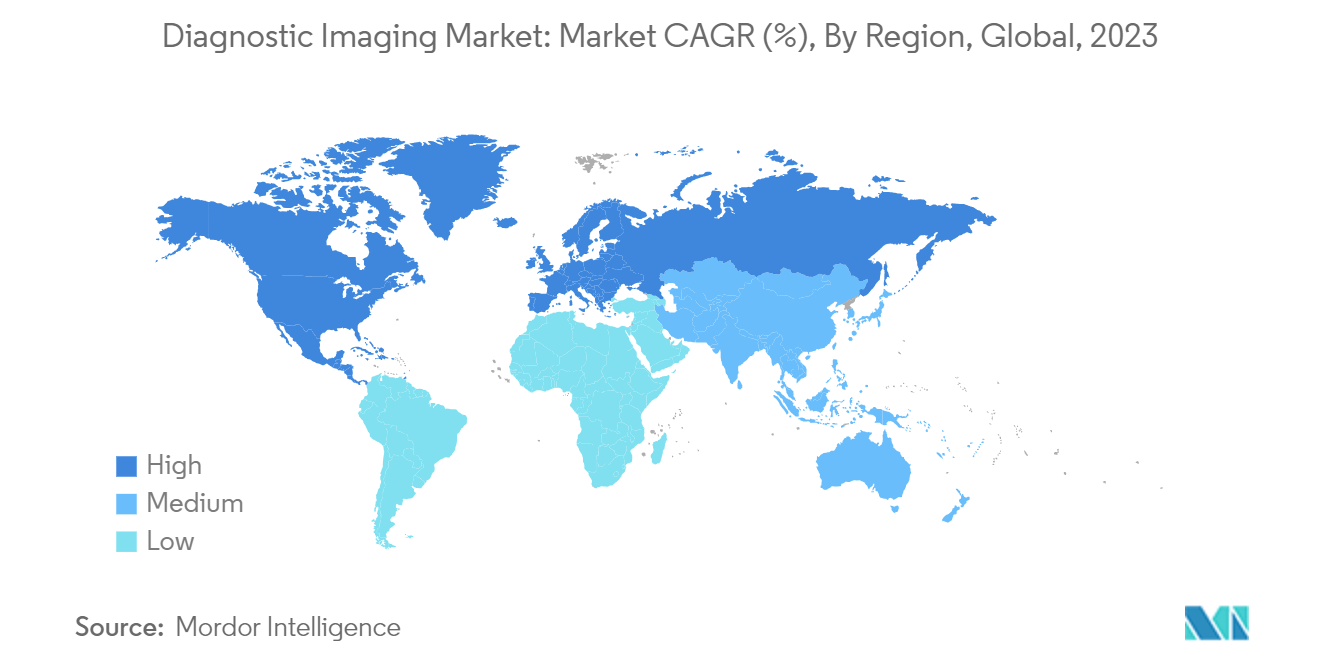
Diagnostic Imaging Industry Overview
The market studied is fragmented owing to the presence of several players in the market. The competitive landscape includes an analysis of a few international as well as local companies that hold large market shares and are well known. Siemen Healthcare, Koninklijke Philips NV, GE Healthcare, Hologic Corporation, and Mindray Medical International Limited are some of the most important companies in the market.
Diagnostic Imaging Market Leaders
-
GE Healthcare
-
Koninklijke Philips N.V.,
-
Siemens Healthineers
-
Mindray
-
Hologic, Inc.
- *Disclaimer: Major Players sorted in no particular order
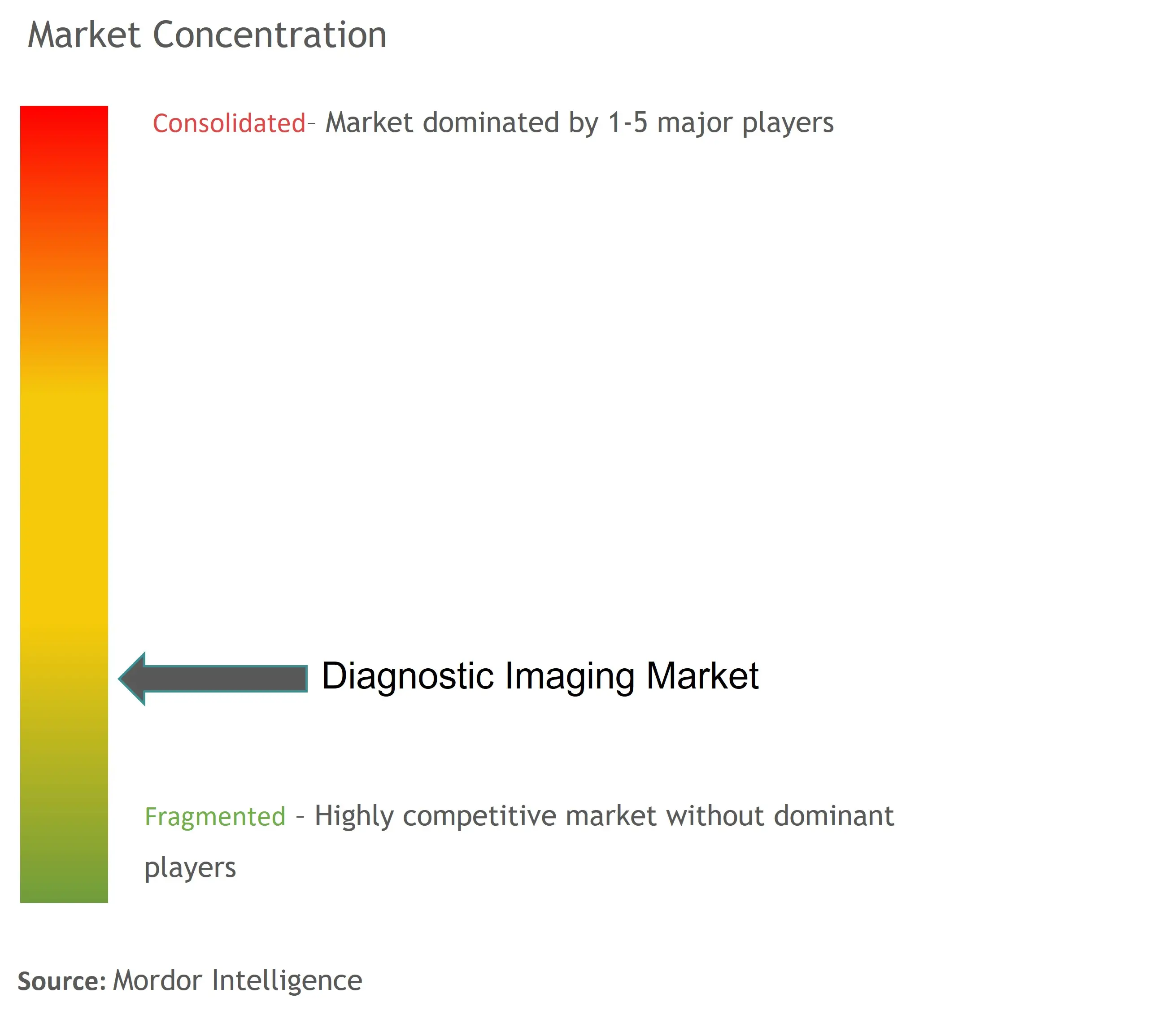
Diagnostic Imaging Market News
- July 2022 : Canon Medical launched the Vantage Fortain MRI System at ECR 2022, This MRI system features innovative workflow solutions, image enhancements and accelerated scan technology, which together contributes to reducing the time required for MRI procedures.
- April 2022 : Wipro GE Healthcare launched the next-generation Revolution Aspire CT scanner. Revolution Aspire is an advanced imaging solution designed and manufactured end-to-end in India.
Diagnostic Imaging Industry Segmentation
As per the scope of the report, diagnostic medical imaging is a common technique to help visualize physical diagnosis in the clinical community. For diagnostic purposes, these systems are used to image the body to obtain a correct diagnosis and determine future care. Diagnostic imaging is the technique or process of creating visual illustrations of the inner body parts for clinical examination and medical interpolation, along with the visual representation of the function of certain organs or tissues. It has a vast range of applications in a variety of oncological, orthopedic, gastroenterological, and gynecological fields. The Diagnostic Imaging Market is Segmented by Modality (MRI (Low and midfield MRI systems (Less than 1.5 T), High field MRI Systems (1.5-3 T), and Very High and Ultra High Field MRI Systems (3T and More)), Computed Tomography (Low-End Scanners (~16-Slice), Mid Range Scanners (~64-Slice), and High-End Scanners (128-Slice and More)), Ultrasound (2D Ultrasound, 3D Ultrasound, and Other Ultrasound), X-Ray (Analog Systems and Digital Systems) Nuclear Imaging (Positron Emission Tomography (PET) and Single Photon Emission Computed Tomography (SPECT)), Fluoroscopy, and Mammography); Application (Cardiology, Oncology, Neurology, Orthopedics, Gastroenterology, Gynecology, and Other Applications); and Geography (North America, Europe, Asia-Pacific, Middle East and Africa, and South America). The report offers the value (in USD million) for the above segments. The market report also covers the estimated market sizes and trends for 17 countries across major regions globally. The report offers the value (in USD million) for the above segments.
| By Modality | MRI | Low and mid field MRI Systems (less than 1.5 T) | |
| High field MRI Systems (1.5-3 T) | |||
| Very High and Ultra High Field MRI Systems (3T and more) | |||
| Computed Tomography | Low-end Scanners (~16-Slice) | ||
| Mid-range Scanners (~64-Slice) | |||
| High-end Scanners (128-Slice and More) | |||
| Ultrasound | 2D Ultrasound | ||
| 3D Ultrasound | |||
| Other Ultrasound | |||
| X-Ray | Analog Systems | ||
| Digital Systems | |||
| Nuclear Imaging | Positron Emission Tomography (PET) | ||
| Single Photon Emission Computed Tomography (SPECT) | |||
| Fluoroscopy | |||
| Mammography | |||
| By Application | Cardiology | ||
| Oncology | |||
| Neurology | |||
| Orthopedics | |||
| Gastroenterology | |||
| Gynecology | |||
| Other Applications | |||
| By End User | Hospital | ||
| Diagnostic Centers | |||
| Other End Users | |||
| Geography | North America | United States | |
| Canada | |||
| Mexico | |||
| Europe | Germany | ||
| United Kingdom | |||
| France | |||
| Italy | |||
| Spain | |||
| Rest of Europe | |||
| Asia-Pacific | China | ||
| Japan | |||
| India | |||
| Australia | |||
| South Korea | |||
| Rest of Asia-Pacific | |||
| Middle East and Africa | GCC | ||
| South Africa | |||
| Rest of Middle East and Africa | |||
| South America | Brazil | ||
| Argentina | |||
| Rest of South America | |||
Diagnostic Imaging Market Research FAQs
How big is the Diagnostic Imaging Market?
The Diagnostic Imaging Market size is expected to reach USD 48.92 billion in 2025 and grow at a CAGR of 4.18% to reach USD 60.04 billion by 2030.
What is the current Diagnostic Imaging Market size?
In 2025, the Diagnostic Imaging Market size is expected to reach USD 48.92 billion.
Who are the key players in Diagnostic Imaging Market?
GE Healthcare, Koninklijke Philips N.V.,, Siemens Healthineers, Mindray and Hologic, Inc. are the major companies operating in the Diagnostic Imaging Market.
Which is the fastest growing region in Diagnostic Imaging Market?
Asia Pacific is estimated to grow at the highest CAGR over the forecast period (2025-2030).
Which region has the biggest share in Diagnostic Imaging Market?
In 2025, the North America accounts for the largest market share in Diagnostic Imaging Market.
What years does this Diagnostic Imaging Market cover, and what was the market size in 2024?
In 2024, the Diagnostic Imaging Market size was estimated at USD 46.88 billion. The report covers the Diagnostic Imaging Market historical market size for years: 2019, 2020, 2021, 2022, 2023 and 2024. The report also forecasts the Diagnostic Imaging Market size for years: 2025, 2026, 2027, 2028, 2029 and 2030.
Our Best Selling Reports
Diagnostic Imaging Industry Report
The global medical imaging market is on a substantial growth curve, driven by an increase in lifestyle-related diseases, an aging population, and significant technological advancements aimed at early disease detection. The integration of artificial intelligence for streamlining image analysis aids in conditions such as age-related macular degeneration, marking a shift towards more efficient diagnostic measures. With government initiatives and healthcare investments promoting the adoption of sophisticated imaging tools, especially in underserved regions, the market is seeing notable innovation. Among these are AI-enabled MR imaging portfolios that contribute to enhanced radiology operations' efficiency and sustainability. North America leads in market share, credited to substantial healthcare spending and the adoption of cutting-edge equipment. Following closely is the Asia Pacific region, driven by its increasing demand for sophisticated diagnostic solutions. The market is set for robust growth, underscored by a rising adoption of ultrasound and CT imaging systems that have become indispensable in diagnosing and managing a wide spectrum of health conditions. Insights from Mordor Intelligence™ highlight the crucial role of diagnostic imaging companies in this dynamic market expansion, indicating a promising future for the industry. Get a sample of this industry analysis as a free report PDF download.



